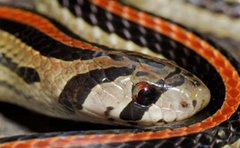This Banded Krait (Bungarus fasciatus), photographed by Loh Kok Sheng and posted in his blog, made a pleasantly surprised appearance at the launch of the Chek Jawa Wetlands on the morning of 7 July 2007.

Norman Lim encountered this snake last year, also along a muddy shore, but on another northern island of Singapore. This 'common occurence' of banded kraits in aquatic habitats are unusual because these are known to be terrestrial snakes. Maybe we just do not know much about them.

It is common that people misidentified the Banded Krait as the Yellow-lipped Sea Krait (pictured above). Both species belong to the same family of Elapidae (a group of venomous snakes including cobras, old-world coral snakes and true sea snakes). However, kraits belong to the genus Bungarus while sea kraits belong to the genus Laticauda. Although both snakes have the black-and-white bands along their body, the Banded Krait lacks the paddle-shaped tail tip that its cousin Yellow-lipped Sea Krait possesses. This tail shape allows the sea krait to swim more efficiently in the open sea.


Tails of Banded Krait (above) and Yellow-lipped Sea Krait (below).
* All photographs by Loh Kok Sheng and Ria Tan.


Tails of Banded Krait (above) and Yellow-lipped Sea Krait (below).
* All photographs by Loh Kok Sheng and Ria Tan.





